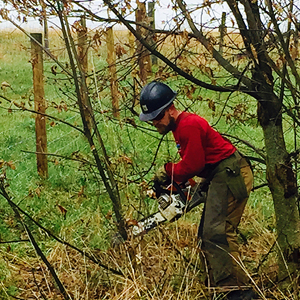In the quest to create a population of blight resistant American chestnut trees through backcross breeding, large numbers of trees have been planted and screened for resistance to chestnut blight. We aim to select the 1% most blight-resistant trees that will be a source of seed for restoration. Since 2002, over 60,000 American chestnut backcross trees have been planted in seed orchards at TACF’s Meadowview Research Farms. As these trees are planted, we have been inoculating them at age two with the fungus that causes chestnut blight. Susceptible trees that develop large and sunken blight cankers are removed. As of January 2017, there were 8246 trees remaining in Meadowview seed orchards. Our final goal is to cull all but 500 to 600 of the most resistant trees.

Steve Hoy, orchard manager with the PA/NJ Chapter, rogueing at Meadowview Research Farms.
This winter, we visually assessed all remaining trees. Trees that demonstrated symptoms of susceptibility, including those with a dead main stem and large sunken cankers, were removed. Dan Mckinnon, our seed orchard supervisor and Steve Hoy from the Pennsylvania chapter of TACF, carefully removed many trees that were planted at close spacing, some as close as one foot apart! Together they removed a total of 2,705 trees leaving 5,500 trees.
To make final selections in the Meadowview seed orchards, we are screening progeny of a subset of the remaining trees for resistance to chestnut blight. It is not feasible to screen progeny from all remaining trees. To speed up selection, we are estimating the relationships between DNA sequence variation and the average canker sizes of the progeny from mother trees that vary in their genetic levels of resistance to chestnut blight.
Through understanding the relationships between DNA sequence and blight resistance, we aim to predict the underlying genetic resistance of remaining selections from DNA sequence alone. This method, called genomic selection will enable us to pick the winners more accurately (i.e., the most genetically resistant trees) and significantly speed up the process, allowing us to cull the rest in as little as three years!
